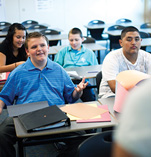Practical Strategies for Teaching Students with Autism
More information
Early signs of autism
The roots of autism are in early brain development, but the most obvious signs and symptoms tend to emerge between 2 and 3 years of age. The following “red flags” in the first two years of life may indicate your child is at risk for an autism spectrum disorder.
- No big smiles or other warm, joyful expressions by 6 months or thereafter.
- No back-and-forth sharing of sounds, smiles or other facial expressions by 9 months.
- No babbling by 12 months.
- No back-and-forth gestures such as pointing, showing, reaching or waving by 12 months.
- No words by 16 months.
- No meaningful, two-word phrases by 24 months.
- Any loss of speech, babbling or social skills at any age.
Source: Autism Speaks (www.autismspeaks.org)
Excerpts from “Strategies at Hand: Quick and Easy Strategies for Working with Students on the Autism Spectrum”
A few strategies for riding the bus:
- Assign seating behind bus driver or next to a bus buddy.
- Make available earplugs/headphones/music with earphones.
- Shorten bus ride if possible.
- Assign students to same seat every day
A few strategies for the cafeteria:
- Provide visual menu
- Assign a lunch buddy
- Provide conversation starter cards
- Assign seating
- Make available a “quiet spot” for eating
A few strategies for academics:
- Hand out one assignment at a time
- Allow student alternatives to handwritten assignments (keyboarding, dictating/recording responses)
- Have available different types of paper (raised lines, different spacing, colored paper)
- Use study guides
Support at UNC
As more children are diagnosed with autism spectrum disorder and go through the public school system, higher education is becoming a greater option for many of them. In the past year, several students with Asperger’s syndrome, which is on the autism spectrum, have graduated from UNC.
The UNC office of Disability Support Services serves about 400 students, a handful of whom are identified as being on the autism spectrum.
Students come to the office with documentation of their disability from a professional, and the office works with the student individually to get certain accommodations in the classroom, such as extra time on exams or help from a notetaker.
One of the biggest challenges for students with disabilities is learning to advocate for themselves, says Ann Murphy, director of Disability Support Services.
“In the smaller K-12 arena, there is closer monitoring and students have had a lot of things done for them,” she says. “But here, they need to come to us and let us know how they are doing. It’s important that they learn to be more independent as they prepare to enter the workforce. We can help them make that transition from K-12 to the work environment.”







